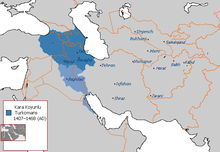Yiwa (tribe)
 Tamgha of the Yiwa tribe | |
| Regions with significant populations | |
|---|---|
| Azerbaijan, Turkey, Turkmenistan | |
| Languages | |
| Oghuz Turkic | |
| Religion | |
| Islam | |
| Related ethnic groups | |
| Oghuz Turks |
Yiwa[1] (Azerbaijani: Yıva, Turkish: Yıva, Turkmen: Ywa) was one of the 24 ancient Oghuz (Turkoman) tribes.[2][3] The Yiwa tribe belonged to the tribe of Dengiz Khan, the youngest son of Oghuz Khagan.
Part of the Yiwa, led by Suleyman Shah, moved from Central Asia to Western Iran and the upper reaches of Tigris and Euphrates in the 13th century. The capital of Suleyman Shah became the city of Bahar (near Hamadan). Suleyman Shah led the defense of Baghdad against the Mongols of Hulagu and was defeated.[4]
History
By the 14th century, the Yiwa had established a foothold in eastern Anatolia, and took possession of the area comprising the Van Lake and the surroundings of Mosul.[5]
Qara Qoyunlu

The Qara Qoyunlu rulers descended from the Yiwa tribe, specifically the Baharlu tribe.[6]
Yiwa today
Descendants of the Yiwa tribe are assimilated into Azerbaijani, Turkish and Turkmen turks. Sizable group of the Yiwa, mostly ethnic Turkmens, also live in the Olat region of Bukhara, Uzbekistan.[7]
References
- ^ Sümer F. (24 April 2012). "Ḳarā-Ḳoyunlu". Encyclopaedia of Islam.
- ^ Fazlallah Rashid ad-Din (1858). "Legends about Oghuz Khagan. Tribal division of the Turkmens. (Extracts from Jami at-Tavarikh)". Medieval Historical Sources of the East and West. Eastern Branch of the Russian Archaeological Society, vol. V and XV, St. Petersburg.
- ^ Abulghazi (1958). "The Genealogy of the Turkmen". Medieval Historical Sources of the East and West. Academy of Sciences of the USSR.
- ^ Ryzhov, K.V. Kara-Koyunlu. All the monarchs of the world. The Muslim East. VII-XV centuries. Veche, 2004
- ^ Clifford Edmund Bosworth. The new Islamic dynasties: a chronological and genealogical manual. — Edinburgh University Press, 2004 — p. 273—274 — ISBN 0-7486-2137-7
- ^ Peter B. Golden (1992). An Introduction to the History of the Turkic Peoples. pp. 367–368.
- ^ Ataniyazov, S. Dictionary of the Turkmen ethnonyms. Ylym; Ashgabat. 1988.
